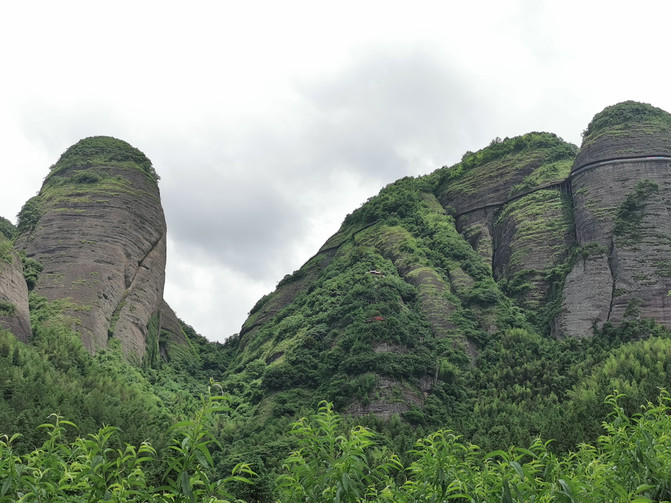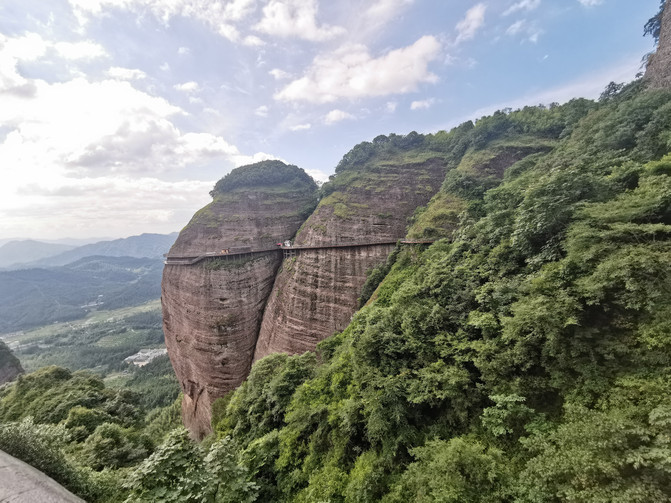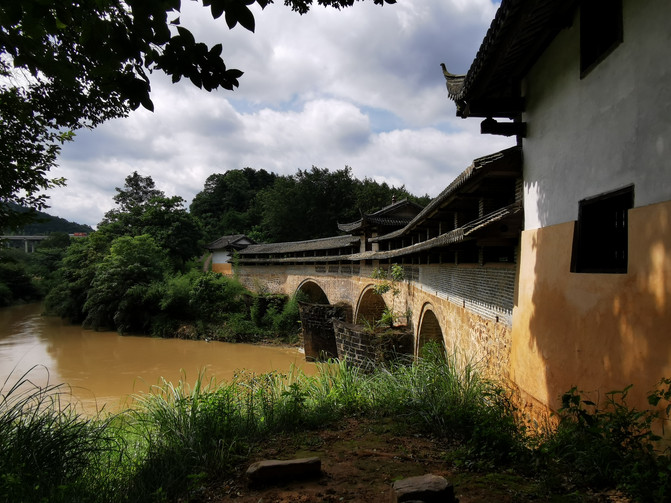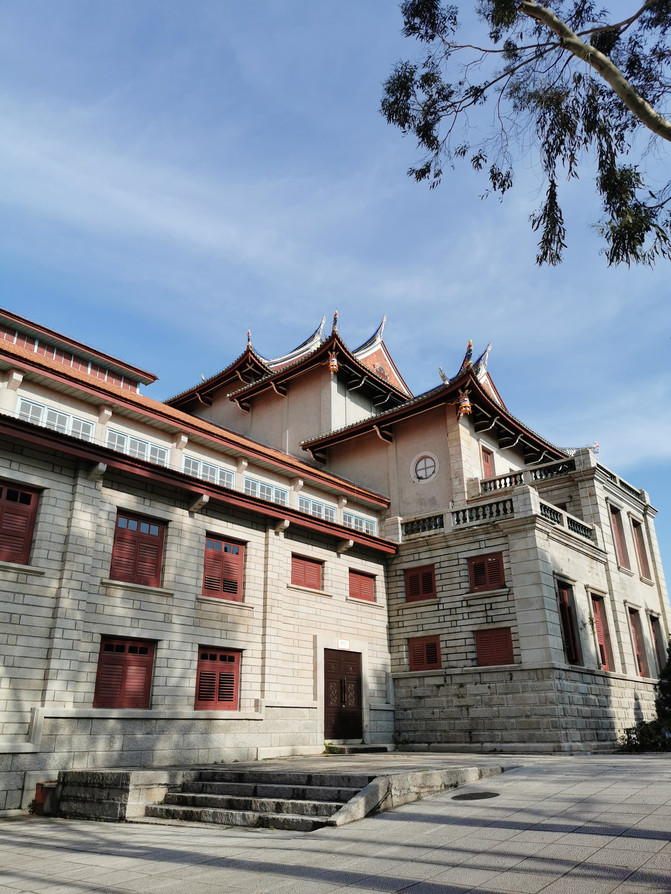June 2019 Sisters in Ganzhou and Xiamen
Aerial Photography of China in Jiangxi contains an introduction to the ancient pontoon bridge and enclosed houses in Ganzhou. I want to see it with my own eyes. After telling my sisters, they were also very eager to go to Ganzhou together in June.
My itinerary:
Day 1, 6/15: Shanghai--Ganzhou--Yongjinmen--Zaoer Lane--Urban area
6/16 of the next day: Jianchunmen--Ancient Pontoon Bridge--Yugu Terrace--Ancient City Wall--Fushou Gully--Jiang Jingguo Residence--Bajingtai--Xijinmen
Day 3 6/17: Ganzhou-Xiaowangdang Mountain (180 kilometers and 2.5 hours drive)--Yangcun Town
Day 4, 6/18: Yangcun Town--Xinwei--Wushiwei--Taiping Bridge--Yanyiwei
Day 5 6/19: Yangcun Town--Yudai Bridge--Dasheng Temple Tower--Ganzhou--Xiamen
Day 6/20: Nanputuo--Xiamen University--Zeng Cuo 'an--Seaside
Day 7 6/21: Gulangyu
Day 8 6/22: Xiamen--Zhongshan Road--Shanghai Hongqiao Airport
Day 1 6/15: Shanghai----Ganzhou
Flights from Pudong Airport at 10:10 a.m., and arrives at Ganzhou Golden Airport (RMB760) at 12:00. The airport shuttle is 10/person to the city center. I booked in advance at Home Inn Ganzhou Hongqi Avenue People's Hospital Nanmenkou at RMB127/standard room. After checking in, I went out to Yongjinmen and took a taxi. Ganzhou taxis were very cheap. We basically used taxis for transportation. After getting off the bus, we had lunch at a small restaurant opposite Yongjinmen. Six people spent 173 yuan, which was cheap, delicious and full. After dinner, we first went for a stroll in Zao 'er Lane and took a nap at Dongfu Hotel, a government office during the Republic of China. After leaving Zao 'er Lane, there was Jianchun Gate opposite him and we took a stroll along the city wall. I found an Internet celebrity restaurant for dinner that evening. The cost was 263 yuan, but it was still cheap.
Zao 'er Lane: The most primitive market flavor in southern Jiangxi
This is a typical ancient city street-Song Shiming's bricks and clear tiles are piled up with a period of vicissitudes of life. The cornices, flower lintels, and carved windows reflect the old and glorious dreams. The alleys made of cobblestones, through each pattern of "Ming Qian", seem to trap time in an era when clogs are kicking, making elderly people feel cordial and nostalgic when they approach them.
Coordinates: Heping Road, Zhanggong District, Ganzhou City, Jiangxi Province




6/16 the next day: I got up early and came to Jianchun Gate again. I first visited the Prince Tower opposite. There were some photos of the year where Jiang Ching-kuo worked. Then I went to see the ancient pontoon bridge, but I couldn't find it everywhere. I asked the local people and said that it was due to heavy rains a few days ago and the river surged. In order to prevent accidents, the ancient pontoon bridge had been demolished. I don't know when it will be built again. I am unwilling to do so, which is a pity...
Walking along the city wall in the direction of Bajingtai, as we walked and looked, there were indeed a lot of yellow silt on the road, left behind by the river water overflowing the river bank and receding. Local sanitation workers were cleaning it up. I met a middle-aged man who was setting up a stall. During the chat, he talked about his Ganzhou with great enthusiasm, his tone full of pride and pride, and introduced us to the history of the city wall and some interesting things. To show my gratitude, I wanted to buy his old map, but he declined politely. A good person. After seeing Bajingtai, Yugu Terrace, and Jiang Ching-kuo's apartment in turn, it was already afternoon. I found a restaurant on the roadside and had lunch at RMB267. Then I went back to home to rest. It was hot that day and the sun was burning, so I needed rest to replenish my strength. After going out for dinner (RMB237) in the evening, I took a walk along the Zhangjiang River and blew the river breeze, which was very pleasant.
Ancient pontoon bridge: Inheriting thousands of years of ancient customs and clear charm (Jianchunmen)
This 800-year-old pontoon bridge is a unique pontoon bridge in the country. It has become a unique scenic spot in Ganzhou City and is known as a unique sight in Ganzhou. I don't know how much blood and smoke of war we have experienced. The new bridge becomes old, the old bridge is replaced, repaired, and gone through vicissitudes, like an indomitable old man standing tall beside the Zhangjiang River.
Coordinates: within Zhanggong District, Ganzhou City, Jiangxi Province
The ancient city wall of Ganzhou was built in the Han Dynasty and has a history of 2,000 years. The relatively completely preserved ancient city wall was built during the Jiayou period of the Northern Song Dynasty. It is the largest existing ancient city wall in Jiangnan and one of the few Northern Song Dynasty brick walls in the country. one.



Food:
Dongfu (Gancai)-Zaoer Lane;
Taizi Tower--The former post office, the former site of Chiang Ching-kuo's Administrative Office, is now Gancai Restaurant (you can visit it by the way) Opposite is Jianchun Gate
Recipe: Sauteed fish, raw and braised duck, spicy Chinese yam, stone fish and radish, three-cup chicken, steamed pork with rice flour, Amio, Xingguo rice noodle fish...(The two restaurants are the same owner)(Suggest dinner here on the Gongjiang River)
Accommodation: The scenic spot is mainly in the old Urban area, so for convenience of travel, the hotel will try to arrange it in the old Urban area as much as possible. Across the Zhangjiang River is a development zone with many luxury hotels.
6/17 of the third day: The chartered car driver came to pick us up early in the morning. We booked a car from Ganzhou International Travel Service and set off for Xiaowudang Mountain in three days. We arrived in front of the scenic spot in three hours. First, we had lunch at a nearby farmhouse and began to climb the mountain with high spirits.
Little Wudang Mountain is not very high, but it is really killing to climb up. Its line is all the way up and there is no cableway, which is very strenuous. All afternoon, I finally went down the mountain and was almost exhausted.
Longnan Xiaowudang: Danxia Landform is magical
Coordinates: Shixia Village, Wudang Township, 50 kilometers south of Longnan County, Ganzhou
After going down the mountain, we head to Yangcun Town. After investigation, the nearest road from Xiaowudang Mountain to Yangcun Town had been washed out due to flood, so it was diverted into Guangdong Province first, and then back to Jiangxi to Yangcun Town, which took an extra half hour. I had dinner at the hotel and the food was good.


6/18 of the fourth day: Get up early and depart from Yangcun Town to Xinwei, Kansai. The ticket was bought together with Xiao Wudang Mountain yesterday. There were only six of us in the scenic area. We invited a tour guide to explain the way. We were very dedicated and talked for more than an hour. In hot weather, the sun is shining, back to Yangcun Town. Because Wushiwei was not far from Yangcun, we first went to the accommodation hotel for lunch and set off for Wushiwei again. The sisters laughed and took beautiful photos all the way. They were very happy.
The second stop, Taiping Bridge, is 5 kilometers away from Wushiwei, which is very close. However, as soon as the car drove to Taiping Bridge, I just picked up my mobile phone to take a photo, and raindrops fell down. She hurriedly took a photo and quickly jumped into the car. It was also because of the previous heavy rain that the flood washed up the Taiping Bridge and was under repair. Passers-by could not get on the bridge and could only watch from a distance. Well, let's see its majestic appearance. Back at the hotel, the rain stopped and the sun was shining high. This weather was really playing hide-and-seek with us. Next to the hotel is Yanyiwei. There are several elderly people sitting at the door chatting. They are not curious when they see us and let us visit freely.
There is a low-key town in the south of Jiangxi. It is clearly the city with the largest area and the largest population in Jiangxi, but it still retains many traditional Hakka customs. This is the place with the largest number of Hakka enclosed houses. The enclosed houses here are not only large in area, but also large in number. They have a long history and are simply real mansions. The greening rate here has reached 76%, and it is full of oxygen ions everywhere. It is more suitable to live here for a while. She is Ganzhou. Although it is Jiangxi's largest city in area and most populous, it is also the most easily ignored.
Xinwei, Kansai: Ancient Roman Castle of the Orient
It is the most well-preserved enclosure found at home and abroad, and it is also the largest. This magical enclosure has a history of more than 180 years, and it took nearly 30 years to build it. Xinwei in Kansai is the largest among the existing Hakka houses in southern Jiangxi. The main enclosure covers an area of about 8000 square meters and was built during the Jiaqing period of the Qing Dynasty. The main house structure inside the enclosure is a typical building among the characteristics of Hakka houses. There are still people living in Xinweili. The people here speak Hakka. Sometimes you can see people coming back from work here. Walking in the Kansai enclosure is like time has an illusion, walking back hundreds of years along the tunnel of time.
Address: Located next to Kansai Wei, about 15 kilometers east of Longnan County, Jiangxi Province
Yangcun Yanyiwei: A History of Hakka Changes
Yanyiwei is a national key cultural relic. It was built during the Shunzhi period of the Qing Dynasty. It has been more than 320 years since then. It was built by Lai Fuzhi in Yangcun. It takes the name of the enclosure from the word "Yanyi" in the Book of Mountains and Seas,"The first time is Rongchang, Yan Yi is a traitor". It means foresight and descendants of Rongchang. To enter the enclosure, you must pass through the only enclosure door. The enclosure door is equipped with an outer iron gate, a middle gate and an inner wooden door. As long as the enclosure door is closed, no outsiders want to enter. There is a rice warehouse upstairs and a well in the courtyard. Legend has it that the walls are painted with glutinous rice flour, brown sugar and egg white. When there is nothing to eat, they can be peeled off and boiled with water to satisfy their hunger. There is a trumpet-shaped funnel at the base of the wall about 1 foot above the ground, which is used to drain sewage.
Address: Located in Longnan County, Ganzhou City
Wushi Wai: A wonderful thing in the enclosed house
Yangcun Wushiwei is located in Wushiwei on the Dongshui River in Yangcun Town, Longnan County. Because there is a large black stone lying on the left side in front of the gate, the enclosed house is named Wushiwei, also known as Panshiwei. Wushi Wai, built during the Wanli period of the Ming Dynasty, has a semicircle in front and back. Among the many Hakka houses with different styles, it can be said to be unique and particularly precious. Wushi Wai covers an area of about 4500 square meters. Wushiwei in autumn is very quiet. The weeds by the moon pond in front of the door have turned yellow, and the leaves of the trees by the outer wall have become more and more sparse. The fields outside are bright golden, which is the color of a bumper harvest.
Address: Wushiwei by the Dongshui River in Yangcun Town, Longnan County
Taiping Bridge in Yangcun Town: Located in Chetian Village, Yangcun Town, Longnan County, Ganzhou, Jiangxi Province, 62.5 kilometers away from Longnan County and spans the Taiping River. It is a stone arch bridge built in the late Ming and early Qing Dynasties. Located on the Taiping River, three miles north of Yangcun Street, there is a double-layered overlapping stone arch bridge with two holes, three piers, and four arches. The bridge was rebuilt between Jiaqing and Daoguang in the Qing Dynasty, and the main bridge body is intact. It is said that in the spring of the 13th year of Zhengde in the Ming Dynasty, Wang Shouren, the Imperial Censor of Zuo Qian of the Ducha Court and the Governor of Southern Gan, led his officers and soldiers into Taiping Fort in Longnan to suppress the Taiping Peasant Uprising and then the Sanli Peasant Uprising in Guangdong. Returning to Ganzhou Prefecture, Wang Shouren built a Taiping Bridge at Shuikou Ridge in Taiping Fort to show that the world is peaceful. When the bridge was completed, a huge strange stone suddenly appeared more than ten meters downstream of the bridge, resembling a lying buffalo hemp. At night, Buffalo Ma goes to Lianping Prefecture, Guangdong Province to find grain. At the beginning of the reign of Daoguang in the Qing Dynasty, a Feng Shui master said: "If the divine cow is under the bridge, it will climb abroad. If the divine cow is on the bridge, it will ensure peace and prosperity." Following Mr. Feng Shui's instructions, the villagers rebuilt a Taiping Bridge, the present Taiping Bridge, 100 meters downstream of the original bridge, and demolished the original bridge. They also carved an ancient water buffalo and matched it with water buffalo hemp and placed it at the entrance of Laowei in Chetian Village. When the bridge was completed, Lai Maojie (1794-1872), the supervisor of Jiugong's bridge construction, wrote the three characters "Taiping Bridge" on the forehead north of the Sitong Pavilion. It is vigorous and powerful and can be called a calligraphy treasure.
The completion of Taiping Bridge has left convenience for pedestrians and added a scenic spot to Yangcun. The Taiping Bridge is 50 meters long and has a unique shape. It has an overlapping combination of four arches and a four-way pavilion on it to facilitate pedestrians to see and rest.






Day 5, 6/19: On the third day of chartered cars, return to Ganzhou. Go to Yudai Bridge first on the way, 55 kilometers, 1.5 hours drive.
Yudai Bridge-Located in the central village of Hushan Township, 40 kilometers away from the county seat, it flies over the Hushan River. It was built in 1740 and is also known as the "Fengqi Bridge". It is a two-pier three-hole house-type arch bridge. The bridge body is in an arc and the bridge is 88.15 meters long. It is the longest existing arc-covered bridge in Jiangnan. It left behind the "famous Jade Belt Bridge, with high peaks on both sides entering the sky." The rushing river flows thousands of miles away, and the jade belt flies to the two mountainsides of the town." Jade Belt Bridge: Because its arc is like a jade belt, it is named. The Yudai Bridge was built in the fifth year of Qianlong of the Qing Dynasty (AD 1740) with funds raised by local tycoon Yu Fengqi, and was also known as the "Fengqi Bridge". In the central village of Hushan Township, about a hundred miles away from the county seat, on the Hushan River that reaches Longzhou. It is named because its arc is like a jade belt flying across the mountains and above the surging rapids. The current Yudai Bridge is not only a national key cultural relic protection unit, but also the "longest existing arc-covered bridge in Jiangnan." After nearly 400 years, the Jade Belt Bridge is still strong and has outstanding charm.
Second stop: Dasheng Temple Tower, 70 kilometers and 1.5 hours drive. Dasheng Temple Tower-Standing on nine floors and six sides in the center of the county, 66.45 meters high. It is the "No. 1 Tower in Jiangnan" located in the city of Xinfeng County. Built during the Northern Song Dynasty, it is a flat hexagonal nine-level pavilions-style brick tower. The Dasheng Temple Tower has nine floors and eighteen levels. After being rebuilt, it is 66.45 meters high. It is known in history as "the top of the sky and the province is unmatched". It is the tallest existing Song Pagoda in Jiangnan. It can be called "the first tower in Jiangnan". Climb the tower and overlook Xinfeng County.
After a short rest, we leave for Ganzhou, 70 kilometers, 1.2 hours drive, and go to Xiamen in the evening. On the bus, I thought of the ancient pontoon bridge. After thinking about it, it was still early for us to go to Xiamen by train at night. After discussing it with the driver, the car took us directly to Jianchun Gate, where we got off and headed straight to the river. Sure enough, the ancient pontoon bridge was there. A group of people cheered and jumped and rushed to the bridge. Of course, there was no shortage of photos. Satisfied, go to the railway station and go to Xiamen by train. 19:10 D6578 Ganzhou-- 22:46 Train to Xiamen RMB150/person. I ate the dry food I brought in the car for dinner. That night, I stayed at the 42-story B & B in Xiamen Twin Towers for RMB1011/night. It has three bedrooms, one living room and two bathrooms. There is a kitchen, so you can make your own simple meals.
Food: Xinfeng County, Yangming East Road (time-honored brand Xinfeng Radish Dumplings)(The map sign is Yangming Middle Road)





6/20 of the sixth day: Get up early, go to Nanputuo Temple first, take the guide, and follow the tour group for a tour. It was so crowded. It was already noon when I left the house. The temperature was 38 degrees that day. It was too hot. I went back to the Twin Towers to rest. I set off for Xiamen University at around 3 p.m., and I had already booked tickets. I happily walked around Xiamen University. It was graduation season and I saw many academic students taking photos on the playground. Wearing bachelor's hats, the proud ones are in high spirits. It's good. Furong Restaurant drank mung bean soup to relieve the heat, took a walk in the tunnel, read the students 'messages, and lamented his student career. Exit the south gate of Xiamen University and follow the seaside to Zengcuo 'an. The sky is slowly getting dark, and the scenery on the beach is getting better and better. Couples are walking holding hands, and the children are playing. Life is so beautiful under the sunset. Zeng Cuo 'an, despite its high online reviews, is just a market in my eyes. Most of them are barbecue-type food, and there are also some unique foods in southern Fujian. But there are no highlights, so just visit it. I still stay in the Twin Towers at night.








6/21 of the seventh day: Check-out in the morning and go to Gulangyu. The ticket is 10:50 for Xiagu Wharf-Neicuo 'ao Wharf for 35 people per person. Accommodation: Gulangyu Island is near Longtou Snack Street with 3 bedrooms, 1 living room and 3 bathrooms. The landlord helped me upgrade to the third floor, which is very comfortable. Pack your luggage and go out on the road. You must check in at all popular spots, regardless of the exposure to the sun, and you will sweat all over your body. Stay at an island B & B in the evening.




Day 8, 6/22: After checking out in the morning, I went to the dock and passed the most beautiful corner on the way. It was a must to take photos. Arrived at Zhongshan Road in Xiamen at noon and found Datong Duck Sliced Shop on Datong Road. This small shop that I never forgot after eating in Xiamen for the first time, and I will not let it go this time. Buy on Zhongshan Road and take big and small bags home. 19:20 p.m. Xiamen Gaoqi Airport MF8545--Shanghai Hongqiao Airport 21:30 T2 RMB500/person, back to my warm home.


Previous Article:Yicheng Yiwei| Live at the heart of Xiamen and enjoy a delicious meal
Next Article:There are luxury cars downstairs and luxury banquets upstairs. This Chaoshan food is a new choice for Xiamen gourmets
